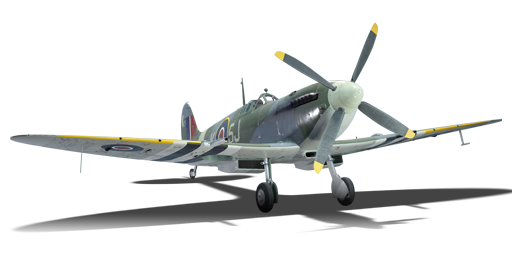


John Plagis was the highest scoring Southern Rhodesian ace of the Second World War, achieving at least 16 aerial victories. Plagis flew the Spitfire LF Mk IX (coded "5J-K", tail number ML214) between 20 June to 7 October 1944 and scored four air victories. While participating in Operation Market Garden, he was shot down by anti-aircraft fire over Arnhem, Netherlands, though he was able to walk away with only minor injuries. His squadron was later re-equipped with Mustang IIIs, in which he served in bomber escort roles until the end of the war. After the war, he flew Gloster Meteors and other jet aircraft until his retirement in 1948.
Introduced in Update 1.49 "Weapons of Victory", Plagis' Spitfire LF Mk IX is very much a short range, point interceptor fighter and the stand-out fighter in the mid Spitfire line-up. It features an exceptional rate of climb, whilst still retaining the manoeuvrability of its early lineage. The LF Mk IX is considered by many to be the perfect Spitfire due to its balanced all-round performance and impressive statistics. The last of the Merlin-engined Spitfires before progressing on to the Griffon-powered variants, it has the perfect balance of turning performance (second only to its Japanese counterparts) as well as its "Boom and Zoom" capability that becomes more possible with later model Spitfires. However, being equipped with the "C" type wing, the Mk IXc is armed with four Browning .303 machine guns to accompany its twin Hispano cannons, which are rather weak compared to the twin .50 cal M2 Browning and Hispano format of contemporary Spitfire models.
Plagis' Spitfire was removed from the Gaijin store in May 2016. It has been made available again in the store for the 2020 "80th Anniversary of the Battle of Britain" event and the 2021 May sale. It has also been available in-game for Golden Eagles for a limited time during the British 2018 "Royal Air Force Centenary", the 2021, 2022, 2023 and 2024 "Battle of Britain Day" and the 2022 "Spitfire Mk.IX first flight" mini-events.
flaps
flaps
flaps
brake
| Belt | Belt filling | Armor penetration (mm) at a distance: | |||||
|---|---|---|---|---|---|---|---|
| 10 m | 100 m | 500 m | 1000 m | 1500 m | 2000 m | ||
| HEI/SAP-I/T | 22 | 20 | 14 | 9 | 6 | 4 | |
| AP-T/HEI/SAP-I | 37 | 35 | 25 | 16 | 10 | 7 | |
| T/HEI/SAP-I/HEI/SAP-I | 22 | 20 | 14 | 9 | 6 | 4 | |
| AP-T/T/HEI | 37 | 35 | 25 | 16 | 10 | 7 | |
| AP-T/SAP-I/HEI/AP-T | 37 | 35 | 25 | 16 | 10 | 7 | |
| HEI/HEI/SAP-I | 22 | 20 | 14 | 9 | 6 | 4 | |
| Belt | Belt filling | Armor penetration (mm) at a distance: | |||||
|---|---|---|---|---|---|---|---|
| 10 m | 100 m | 500 m | 1000 m | 1500 m | 2000 m | ||
| T/AP/AP-I/Ball/Ball/I | 13 | 12 | 7 | 3 | 2 | 0 | |
| T/AP/AP-I/AP-I/I | 13 | 12 | 7 | 3 | 2 | 0 | |
| IT/AP-I | 13 | 12 | 7 | 3 | 2 | 0 | |
| AP-I/AP-I/I | 13 | 12 | 7 | 3 | 2 | 0 | |







 2 x (95 / 225 / 440) %
2 x (95 / 225 / 440) % 
 2 x 166 %
2 x 166 % 

Flight performance | |
|---|---|
Survivability |
|---|
Weaponry | |
|---|---|